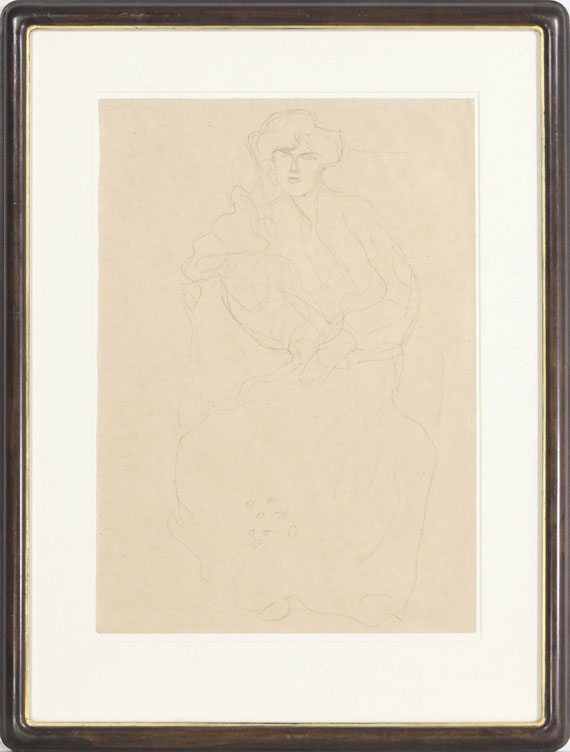404
Gustav Klimt
Im Lehnstuhl Sitzende von vorne, Um 1904.
Brown Chalk drawing
Estimate:
€ 20,000 / $ 23,600 Sold:
€ 50,000 / $ 59,000 (incl. surcharge)
Im Lehnstuhl Sitzende von vorne. Um 1904.
Brown Chalk drawing.
Strobl 1299. Bottom right with the estate stamp (strongly faded). On brownish packing paper. 45 x 31.8 cm (17.7 x 12.5 in), size of sheet.
• Brown chalk is very rare in Klimt's oeuvre.
• Klimt examined the constant line in studies from these days.
• The study must be seen in context of the portrait "Margaret Stonborough-Wittgenstein" (Neue Pinakothek, Munich).
PROVENANCE: From the artist's estate (with the stamp)
Private collection Vienna.
Christie's, London, October 19, 1997, lot 115.
Private collection Switzerland.
Private collection Southern Germany.
EXHIBITION: Yvonne Tan Bunzl Gallery, London.
LITERATURE: Hermann Bahr, Gustav Klimt - 50 Handzeichnungen, Leipzig 1922.
Brown Chalk drawing.
Strobl 1299. Bottom right with the estate stamp (strongly faded). On brownish packing paper. 45 x 31.8 cm (17.7 x 12.5 in), size of sheet.
• Brown chalk is very rare in Klimt's oeuvre.
• Klimt examined the constant line in studies from these days.
• The study must be seen in context of the portrait "Margaret Stonborough-Wittgenstein" (Neue Pinakothek, Munich).
PROVENANCE: From the artist's estate (with the stamp)
Private collection Vienna.
Christie's, London, October 19, 1997, lot 115.
Private collection Switzerland.
Private collection Southern Germany.
EXHIBITION: Yvonne Tan Bunzl Gallery, London.
LITERATURE: Hermann Bahr, Gustav Klimt - 50 Handzeichnungen, Leipzig 1922.
404
Gustav Klimt
Im Lehnstuhl Sitzende von vorne, Um 1904.
Brown Chalk drawing
Estimate:
€ 20,000 / $ 23,600 Sold:
€ 50,000 / $ 59,000 (incl. surcharge)
Headquarters
Joseph-Wild-Str. 18
81829 Munich
Phone: +49 89 55 244-0
Fax: +49 89 55 244-177
info@kettererkunst.de
Louisa von Saucken / Undine Schleifer
Holstenwall 5
20355 Hamburg
Phone: +49 40 37 49 61-0
Fax: +49 40 37 49 61-66
infohamburg@kettererkunst.de
Dr. Simone Wiechers / Nane Schlage
Fasanenstr. 70
10719 Berlin
Phone: +49 30 88 67 53-63
Fax: +49 30 88 67 56-43
infoberlin@kettererkunst.de
Cordula Lichtenberg
Gertrudenstraße 24-28
50667 Cologne
Phone: +49 221 510 908-15
infokoeln@kettererkunst.de
Hessen
Rhineland-Palatinate
Miriam Heß
Phone: +49 62 21 58 80-038
Fax: +49 62 21 58 80-595
infoheidelberg@kettererkunst.de
We will inform you in time.




 Lot 404
Lot 404 

